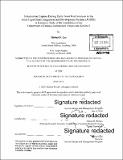| dc.contributor.advisor | Donna H. Rhodes. | en_US |
| dc.contributor.author | Lee, Michael N | en_US |
| dc.contributor.other | Massachusetts Institute of Technology. Engineering Systems Division. | en_US |
| dc.date.accessioned | 2017-03-20T19:42:22Z | |
| dc.date.available | 2017-03-20T19:42:22Z | |
| dc.date.copyright | 2016 | en_US |
| dc.date.issued | 2016 | en_US |
| dc.identifier.uri | http://hdl.handle.net/1721.1/107609 | |
| dc.description | Thesis: S.M. in Engineering and Management, Massachusetts Institute of Technology, School of Engineering, System Design and Management Program, Engineering and Management Program, 2016. | en_US |
| dc.description | Cataloged from PDF version of thesis. | en_US |
| dc.description | Includes bibliographical references (pages 102-107). | en_US |
| dc.description.abstract | The United States has achieved defense superiority in air, land, and sea while using some of the most advanced defense systems in the world. However, underlying this success is a troubled procurement system. Enterprise-wide problems such as poor integration between the three components (JCIDS, DAS, PPBE) of DoD acquisition and inadequate management of procurement personnel have undermined the potential of the Department of Defense. One particular area for improvement is the need for understanding the overlaps, gaps, and interdependencies of the capability portfolio. Information is a precondition to attaining that knowledge. Information is embodied in capability documents and architecture frameworks and drives the critical process of determining the right capability requirements upfront, a vital task in saving costs. (Wirthlin, 1994) The stakeholders need a comprehensive understanding of the capability portfolio during this validation process but information can be trapped in functional stovepipes. DoD Architecture Framework (DoDAF) holds much promise in enhancing the visibility and traceability of information in the capability portfolio to the stakeholders. It is a more structured way to capture and analyze information than free-text documents. The most recent JCIDS manual published in February 2015 added a new requirement to submit seven DoDAF viewpoints during the ICD submission. This indicates the potential of DoDAF viewpoints to be able to provide a full representation of a capability requirement so it can be validated in light of a holistic understanding of the portfolio. The purpose of this thesis is to analyze whether DoDAF alone can provide a holistic understanding of a capability requirement during this early front-end validation. The analysis examines the information captured by the viewpoints by comparing it to ICD information requirements. The results of the analysis reveal the benefits of DoDAF in its ability to capture more detailed information such as resource flows in structured form. A second finding revealed that the seven DoDAF viewpoints were missing key information elements about the capability requirement such as related missions and strategy documents that limit holistic visibility of the capability portfolio. Lastly, there were additional limitations such as the challenge of determining the level of specificity in the viewpoints. Recommendations include changing particular optional data fields to mandatory and adding the CV-1 and OV-3 viewpoints to provide more information about the capability requirement. | en_US |
| dc.description.statementofresponsibility | by Michael N. Lee. | en_US |
| dc.format.extent | 107 pages | en_US |
| dc.language.iso | eng | en_US |
| dc.publisher | Massachusetts Institute of Technology | en_US |
| dc.rights | MIT theses are protected by copyright. They may be viewed, downloaded, or printed from this source but further reproduction or distribution in any format is prohibited without written permission. | en_US |
| dc.rights.uri | http://dspace.mit.edu/handle/1721.1/7582 | en_US |
| dc.subject | Engineering and Management Program. | en_US |
| dc.subject | System Design and Management Program. | en_US |
| dc.subject | Engineering Systems Division. | en_US |
| dc.title | Information capture during early front end analysis in the Joint Capabilities Integration and Development System (JCIDS) : a formative study of the capabilities of the Department of Defense Architecture Framework (DoDAF) | en_US |
| dc.title.alternative | Formative study of the capabilities of the Department of Defense Architecture Framework (DoDAF) | en_US |
| dc.type | Thesis | en_US |
| dc.description.degree | S.M. in Engineering and Management | en_US |
| dc.contributor.department | Massachusetts Institute of Technology. Engineering and Management Program | en_US |
| dc.contributor.department | System Design and Management Program. | en_US |
| dc.identifier.oclc | 974918643 | en_US |
